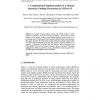Free Online Productivity Tools
i2Speak
i2Symbol
i2OCR
iTex2Img
iWeb2Print
iWeb2Shot
i2Type
iPdf2Split
iPdf2Merge
i2Bopomofo
i2Arabic
i2Style
i2Image
i2PDF
iLatex2Rtf
Sci2ools
HCI
2009
2009
A Computational Implementation of a Human Attention Guiding Mechanism in MIDAS v5
In complex human-machine systems, the human operator is often required to intervene to detect and solve problems. Given this increased reliance on the human in these critical human-machine systems, there is an increasing need to validly predict how operators allocate their visual attention. This paper describes the information-seeking (attention-guiding) model within the Man-machine Integration Design and Analysis System (MIDAS) v5 software - a predictive model that uses the Salience, Effort, Expectancy and Value (SEEV) of an area of interest to guide a person's attention. The paper highlights the differences between using a probabilistic fixation approach and the SEEV approach in MIDAS to drive attention.
Complex Human-machine Systems | Critical Human-machine Systems | HCI 2009 | Human Computer Interaction | Human-machine Systems |
| Added | 18 Feb 2011 |
| Updated | 18 Feb 2011 |
| Type | Journal |
| Year | 2009 |
| Where | HCI |
| Authors | Brian F. Gore, Becky L. Hooey, Christopher D. Wickens, Shelly Scott-Nash |
Comments (0)

